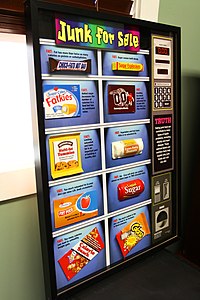
Photo from wikipedia
Background: Schools can play an important role in promoting healthy child diet and body weight. However, this issue is understudied in Latin American and other populations undergoing nutrition and epidemiologic… Click to show full abstract
Background: Schools can play an important role in promoting healthy child diet and body weight. However, this issue is understudied in Latin American and other populations undergoing nutrition and epidemiologic transition. Objectives: 2018 Ecuadorian National Health and Nutrition Survey data were used to examine the association of school food sources with healthy and unhealthy food intake and body mass index (BMI) in primary (n = 12632) and secondary students (n = 6617). Methods: Data on school food environment characteristics were collected by questionnaire, intakes of fruits, vegetables, plain water, sweetened beverages, processed snacks, and fast foods by food frequency questionnaire, and BMI using measured weight and height. Data were analyzed using multivariable methods. Results: The major school food sources were competitive foods sold by commercial outlets (73%), School Breakfast Program (SBP; 52%), and home-packed items (37%). Most (69%) competitive food outlets sold fruits and vegetables but only 44% offered free clean drinking water and 60% sold prohibited “red traffic light” foods. Primary and secondary students who bought competitive foods consumed sweetened beverages, processed snacks, and fast food more frequently than nonpurchasers (P = .0001). Those who packed home foods had higher fruit and vegetable intakes (P = .0001). Plain water intakes were reduced among all SBP participants (P = .0001). However, primary students in the SBP consumed fast foods less frequently (P = .0001) and had lower average BMI and odds for being obese compared to nonparticipants (P = .0001). Conclusion: The findings from this nationally representative study underscore the important contribution of the school food environment to child nutrition.
Journal Title: Food and Nutrition Bulletin
Year Published: 2022
Link to full text (if available)
Share on Social Media: Sign Up to like & get
recommendations!